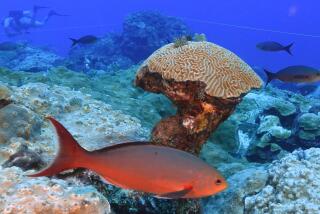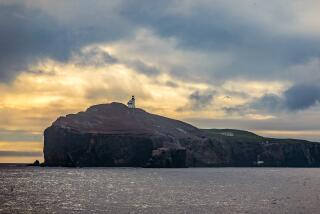SANIBEL Captiva
- Share via
SANIBEL, Fla. — The white sand beaches of the islands of Sanibel and Captiva are some of the best in the world for shell collectors, with more than 400 species. History and legend say that the islands may be the site of hidden treasure but most vacationers only seek the riches of the good life.
Islands intrigue.
Their come-hitherness conjures up images of sun-warmed sands and sea-washed beaches punctuated by palms laden with coconuts. There’s a sorcery in their serenity of isolation. By their geographical separation from the mainland, they magically exorcise the tumult of living in the fast lane. That’s the picture you get from all those travel brochures, right?
Well, what about Florida?
The Sunshine State with Miami Beach, Fort Lauderdale and Disney World hardly calls up that visual image. Yet, strewn on the blue-green waters of the Gulf of Mexico, just off the southwestern edge of the state, lie the barrier reef islands of Sanibel, Captiva, Useppa, Cabbage Key and a handful more. None of them is big; all are barefoot little Edens, each with a distinct personality.
History and legend say that after invaders killed or drove off the original Calusa Indian islanders, marauding pirates, led by a swashbuckler named Jose Gaspar, headquartered in these islands. Following the dictates of their chosen profession, they naturally looted passing ships, carried off helpless maidens, holding them captive. And being buccaneers, it’s said, they buried treasure chests throughout the islands. Dozens are yet to be discovered--at least that’s the story.
But the riches that most visitors come here to find today are not Spanish doubloons or pieces of eight. It’s the blessedness of the good life, island-style, even if it’s only for a fleeting holiday.
Civilization already has a concrete toehold on the islands in the form of a modern causeway that links Sanibel and Captiva to the mainland, doing away with the ferries that were kept busy carrying visitors and residents across the mouth of the Caloosahatchee River less than 20 years ago. The toll is $3 per car and though the cost of building the bridge has been paid, the islanders feel that the fee helps keep undesirables from their shores.
Motorists are deposited on the island’s main street, Periwinkle Way, lined with Australian pines and attractive little shops, boutiques and malls to cater to every need from souvenirs to dog-grooming.
Although the acne of high-rises does not yet blemish the skyline (and won’t if civic-minded islanders continue to have their say), new resorts and condominium time-sharing complexes are rapidly a-building.
My choice, lured by the brochure that pictured an older, traditional structure with wooden verandas, was Casa Ybel with tropical, luxuriant landscaping, royal palms and the much-lauded Thistle Lodge dining room.
Strung along the beach, weathered exteriors house handsome one- and two-bedroom villas with fully equipped kitchens and screened balconies. Not a small complex, it has 40 one-bedroom and 74 two-bedroom town houses (rates $95 to $120 a unit for two daily in summer, $185 and $220 in winter). So it’s great for either families or couples. There’s a tennis pro, lawn games, boat rentals, 18-hole golf privileges and each unit has views of the gulf.
It was from the veranda of my villa that I first saw them on the beach--20 or 30 people bending from the waist, eyes riveted on the sand just beneath them in an attitude of--searching, searching.
What were they looking for, I wondered? A diamond, eyeglasses, contact lenses? Traces of buried treasure?
A friendly maid laughed. What I was seeing, she said, was the famous Sanibel Stoop, a stance that may be modified, perhaps, but adopted by nearly everyone who comes to Sanibel.
For here is one of the three best shelling beaches in the world. (The other two are Jeffreys Bay in Africa and the Sulu Islands in the Southwest Pacific.) More than 400 species of seashells have been found on Sanibel among the billions that are gently washed ashore along 20 miles of soft, white-sand beaches.
That’s a rather impressive reputation for a 12-mile-long island that’s only about three miles at its widest. Still, it gets a little help from neighboring Captiva, to which it’s connected by the short Blind Pass Causeway. Captiva is less than a pin prick on any atlas, measuring a mere five miles long and about half a mile at its widest. But together they make a super pair.
Other attractive resorts on Sanibel include the Sundial with its efficiency suites, deluxe two-bedroom, two-bath apartments, five pools, 13 tennis courts, Morgan’s Market and Lounge and Noopie’s Japanese Steak House. And there’s the Hurricane House with a 1920s kind of charm and casualness in its one- and two-bedroom cottages, plus Song of the Sea, the Tortuga Beach Club and many others.
Most of Captiva is occupied by the handsome, sprawling South Seas Plantation, which was written about in the last Traveling in Style magazine (March 17). And there’s also Tween Waters Inn, smaller but comfortable, nice. It was from Captiva that Anne Morrow Lindbergh, wife of the famous aviator, wrote her best-selling novel, “A Gift From the Sea,” without ever identifying the island she loved so much.
For dining, Thistle Lodge at Casa Ybel was all it was purported to be. Housed in a replica that was part of Sanibel’s oldest resort, the cuisine is great New Orleans, with eggs Sardou, Creole gumbo, broiled redfish, jambalaya and hot buttered pecan pie. For other dining adventures, try not to miss Chadwick’s, Nutmeg House, the Bubble Room or the Mucky Duck. Each one offers a different ambiance--all are good.
What’s to do once you’ve marooned yourself on these islands? It all depends on your stamina. You can (and probably will) go to shell with a hand basket. Or fish (nearby Pine Island Sound is called the “Tarpon Capital of the World”).
You can also play golf, go biking (rentals include three-wheel grown-up bikes that are just great for easy touring), go sailing, take a boat trip and do some bird watching, photograph a pelican or just enjoy the luxury of being lethargic, watching the sun rise and set and becoming gently hypnotized by the never-ending parade of wave upon wave upon wave.
World Shell Fair
Each March a huge Shell Fair draws conchologists from all over the world to display, trade, buy or just talk about their collections.
Half of Sanibel will always be preserved, thanks to the foresight of J. N. “Ding” Darling who set aside 5,000 acres as a national wildlife refuge. It has a visitors center, boardwalk, guided tours, a five-mile driving tour and canoe trails. (And don’t, they cautioned, feed the alligators.)
The two islands are a paradise for bird watchers who can add dozens of endangered species to their notebook sightings.
A scattering of spectacular private homes face the gulf, some of which are up for rental several weeks each year. And with the homes you get famous neighbors. Celebrities return to the islands on holiday, but usually they go into hiding, so don’t count on seeing them. To the island residents’ credit, guarding the privacy of guests is part of what Sanibel is all about.
Boat to Nearby Island
If there’s time, there’s always the adventure of exploring other nearby islands. Boats for hire are plentiful.
Just a watery hop away is Useppa Island in Pine Island Sound, which is rich in a history that begins with the Calusa Indians in 3500 BC. Now it is an elite private club with a reputation for island luxury. The island lay idle for years until a sagacious entrepreneur fell in love with the setting and restored the resort to the magnificence of the original that was created by Barron Collier in 1912. Visitors are welcome on a get-acquainted basis.
Cabbage Key is another neighboring island accessible only by boat (as is Useppa). It is where novelist Mary Roberts Rinehart built a winter home in 1938 and did some of her best writing. A young couple bought it several years ago and run it as an inn that’s particularly popular with the boating crowd. It has six guest rooms, a marina, nature trails and a hospitable dining room that’s papered in thousands of autographed $1 bills.
Thomas Edison Home
If you find yourself afflicted with island fever (though not one case has been recorded to date), there’s always Fort Myers, just a short drive away via the causeway.
Explore Thomas Edison’s winter home and laboratory, board a horse-and-buggy tour, join an Everglades jungle cruise, or if it’s springtime, watch the Kansas City Royals (it’s their winter home) in one of their exhibition games.
After this it’s back to the sanity of Sanibel.
For information:
Lee County Tourist Development Council, P.O. Box 2445, 2126 1st St. North, Fort Myers, Fla. 33902, phone (800) 237-6444; South Seas Plantation Resort, phone (800) 237-3102; Casa Ybel Resort, phone (800) 237-2121; Sundial Beach and Tennis Resort, phone (800) 237-4184 or see your travel agent.
More to Read
Sign up for The Wild
We’ll help you find the best places to hike, bike and run, as well as the perfect silent spots for meditation and yoga.
You may occasionally receive promotional content from the Los Angeles Times.






